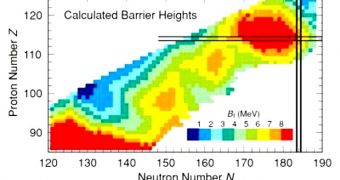Physicists at the US Department of Energy's (DOE) Lawrence Livermore National Laboratory (LLNL), working together with Russian colleagues from the Joint Institute for Nuclear Research (JINR) in Dubna, were able until now to discover five of the heaviest chemicals known to man, elements 113, 114, 115, 116 and 118. But they obviously missed one. The superheavy element 117 was never discovered, in spite of the joint group's best efforts. However, the missing link has just been identified, and the group can now boast having discovered the six heaviest chemicals in the world, PhysOrg reports.
The new element contains no less than 117 protons, which means that it is about 40 percent heavier than the element lead. In order to obtain the construct, the Russian-US collaboration used the JINR particle accelerator, in Dubna, to fuse together the nuclei of calcium and berkelium atoms. The latter chemical is also a very rare and heavy element, the fifth transuranic chemical to ever be synthesized. It is obtained by bombarding americium with helium ions, which are also called alpha particles.
The thing about element 117 is that it is highly unstable, just like all the other five atoms the team discovered. It can only endure for a few fractions of a second, before losing coherency, and exploding into a cascade of smaller, more stable particles. The physics group determined the existence of this element after studying the so-called “daughter” particles that result as it decays. In an ironic twist, though it “lives” for such a short time, the new chemical lasts longer than most of its cousins. The new discovery may also aid scientists in gaining a deeper understanding of the basic principles underlying our Universe, the team believes.
Theories show that the Period Table needs to contain what is referred to as an “island of stability,” which is essentially a range in the mass of combined nuclei that could keep them stable for up to 30 seconds. While this means the elements will be much too short-lived to be used for practical applications, they will give particle physicists the tools they need to analyze precisely how the neutrons and protons that make up all atoms bind together. Details of the work will appear in an upcoming issue of the respected scientific journal Physical Review Letters.

 14 DAY TRIAL //
14 DAY TRIAL //